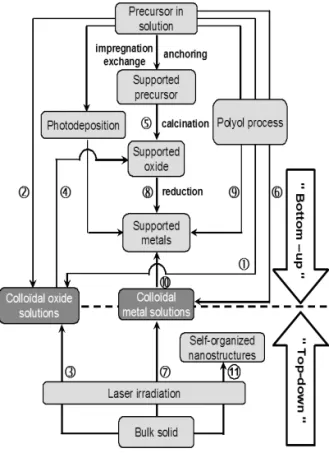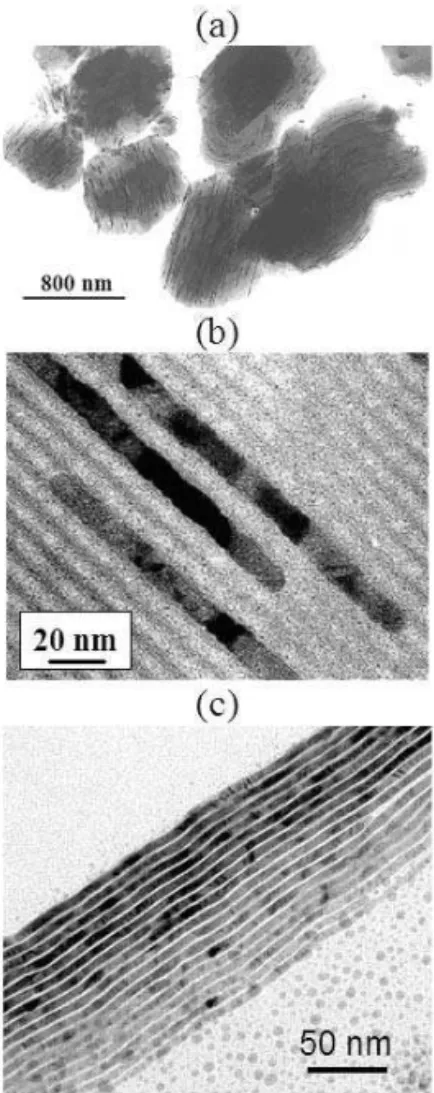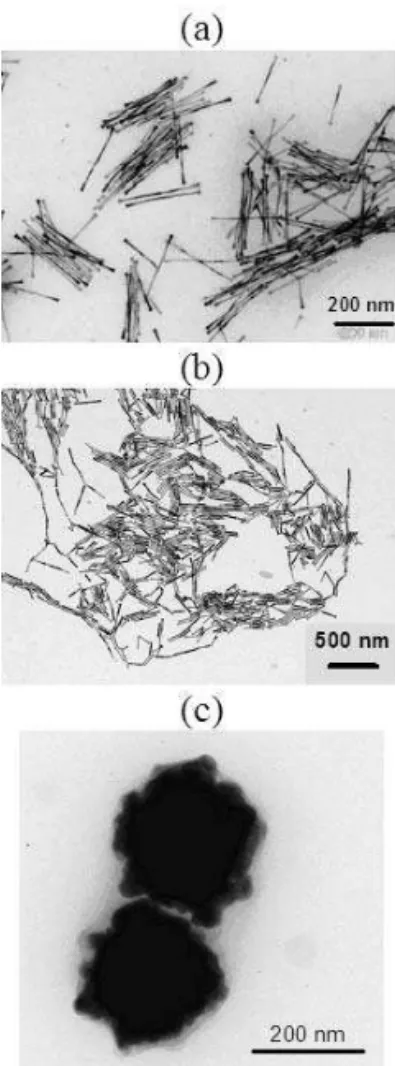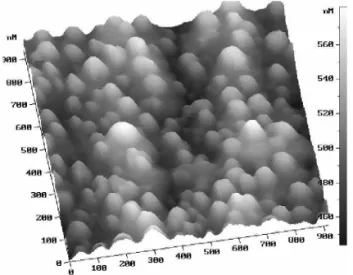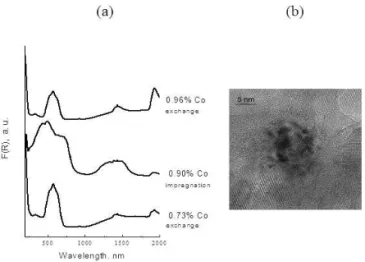Nanoparticles of metal and metal oxides: some peculiar synthesis methods, size and shape control,
application to catalysts preparation
Franc¸ois Bozon-Verduraz,∗Fernand Fi´evet, Jean-Yves Piquemal, Roberta Brayner, Kaoutar El Kabouss, and Yaghoub Soumare ITODYS UMR CNRS 7086, Universit`e Paris Diderot, 15 rue Jean de Ba¨ıf, 75205 Paris cedex 13
Guillaume Viau
Laboratoire de Physique et Chimie des Nano-Objets, INSA de Toulouse, 31077 Toulouse cedex 4
Georges Shafeev
Wave Research Center, General Physics Institute of the Russian Academy of Sciences, Moscow, Russian Federation
(Received on 1 July, 2008)
One step (direct)andmultistepssynthesis methods of metal and oxide nanoparticles are presented including both bottom-up and top-down procedures. Chemical methods involving the polyol process allows to get either isotropic or anisotropic nanoparticles. Nanowires, nanorods and dumbells can be generated either by hetero-geneous nucleation or by using a template (mesoporous silica). Top-down procedures are illustrated by laser irradiation of immersed bulk targets (Ag, Au) which generates self-organized nanostructures or colloidal solu-tions. Laser irradiation of these colloidal solutions modifies the size distribution and the shape of nanoparticles. Bimetallic nanoparticles are generated from mixtures of monometallic colloidal solutions. Surface-mediated methods involving a host support and aninvited phaseare also presented. They lead to the formation of metal or oxide clusters and nanoparticles. The speciation of these entities is correlated with the observed catalytic performances.
Keywords: polyol process, laser ablation, anisotropy, cobalt, palladium, ruthenium, silver, gold.
1. INTRODUCTION
Numerous papers and books have been dedicated to the synthesis of nanomaterials and nanostructures [1,2]. The aim of the present paper is (i) to focus on some peculiar syn-thesis methods developed in our laboratories, pertaining ei-ther to chemical (bottom up) or to physical (top down) meth-ods, (ii) to present their ability to control size and shape; (iii) to show some applications related to catalysts prepara-tion. For conciseness, the cited references are not exhaus-tive and have been mainly chosen to illustrate the synthe-sis methods presented below, dedicated to the genesynthe-sis of metal and oxide nanoparticles. Most examples will con-cern the so-called “zero-dimensional nanostructures”, that are nanoparticles in the general sense (with no peculiar direc-tion of anisotropic growth) and “one-dimensional nanostruc-tures” called nanowires and nanorods[1,2]. Indeed, these anisotropic structures are highly interesting since they ex-hibit properties which differ markedly from those of isotropic nanoparticles. For example, metallic silver nanowires display two plasmon resonances which correspond to longitudinal and transverse collective electron oscillations whereas silver nanospheres only display one resonance. Moreover, the max-imum of the longitudinal oscillation depends on the aspect ratio (length/width ratio) of the particle. In the same man-ner, it is possible to considerably increase the coercive field of ferromagnetic particles, by adding a contribution related to the shape anisotropy [3], which is of outmost importance in the design of magnets. We shall present two classes of proce-dures:one step (direct)andmultisteps. In the latter we focus on supported nanoparticles obtained by either (i) the precur-sor fixation (anchoring, impregnation , exchange) on the host
∗Electronic address:
bozonver@univ-paris-diderot.fr
support, followed by its transformation into theinvited phase (oxide or metal) or (ii) the creation of the invited phasein solution before its fixation (immobilization) on the support. These methods are summarized in scheme 1. For concise-ness, the photodeposition (photo-assisted reduction), which concerns only semiconductors, will not be treated. Collo-dal oxide solutions (sols) can be obtained by hydrolysis of a precursor in solution - polyol process (route 1) or another one (route 2) - or by laser irradiation of a target immersed in an appropriate solvent (route 3). A supported oxide can be designed via either (i) impregnation of the support by a col-loidal solution (route 4) or (ii) calcination of the supported precursor (route 5) obtained from various interaction modes between the support and the precursor solution. Colloidal metal solutions may be obtained by reduction of the precursor in solution via the polyol process (route 6) or by laser irradia-tion of an immersed metal target (route 7). Supported metals are designed through several pathways: (i) reduction of sup-ported oxides (route 8); (ii) reduction of the precursor via the polyol process in a suspension containing the support (route 9); (iii) impregnation of the support by a colloidal metal so-lution (route 10). Finally self-organized nanostructures may be designed by laser irradiation of an immersed target (route 11). The results presented in the present work are limited to routes 2, 5, 6, 7, 11.
2. EXPERIMENTAL SECTION
2.1. Preparation methods
Scheme 1. Flow-chart for the preparation of oxide and metal nanoparticles
2.2. Characterization techniques
X-Ray diffraction patterns were obtained with a Panalyt-ical X’Pert Pro diffractometer equipped with an X’celerator detector, generally in the 10◦−110◦(2θ) range using Co K radiation (λ=1.7889 ˚A). The data were collected at room temperature with a step of 0.017 degrees (2θ) and a time by step equal to 25 s. Transmission electron microscopy (TEM) observations were carried out with a Jeol CXII microscope operating at 100 kV. The sample powder was dispersed in ethanol, one drop of the suspension was deposited on the car-bon membrane of the microscope grid and the solvent was evaporated at room temperature. High resolution transmis-sion electron microscopy (HRTEM) was performed with a Jeol JEM 2010F UHR operating at 200 kV. UV-visible-NIR spectra by transmission and diffuse reflectance were recorded at room temperature between 190 and 2500 nm on a Varian Cary 5E spectrometer equipped with a double monochroma-tor. The integrating sphere used for diffuse reflectance mea-surements was coated with polytetrafluoroethylene (PTFE) and PTFE was used as a reference. Laser ablation in the nanosecond range involved a Cu vapour laser (578 nm) and a Nd: YAG (1064 nm). The morphology of the target was char-acterized by an Atomic Force Microscope (AFM) operating in the tapping mode. The exposed Ag plate was characterized by specular reflectivity using an Ocean optics spectrometer in the 20-650 nm range. DC magnetic susceptibility was mea-sured on a SQUID magnetometer in the 5 - 300 K range under a magnetic field of 200 Oe.
3. DIRECT METHODS FOR THE PREPARATION OF NANOPARTICLES
3.1. Reduction or hydrolysis in polyols: a versatile method to prepare fine metal or oxide particles
The polyol process, developed in our laboratory, is a soft chemistry (”chimie douce”) method which allows to prepare oxide or metal nanoparticles with controlled size and shape [4,5]. The polyol acts as a solvent for the metal precursors (high permittivity), a growth medium and a complexing agent in some cases. In addition, it is also a mild reducing agent. This process permits to tune the particle size, shape, composi-tion and structure of particles via the control of the nucleacomposi-tion and growth steps and, in the recent years, it has called a grow-ing attention. With the help of various additives, surfactants (e.g. polyvinylpyrrolidone) and microwave heating, various types of nanoparticles have been synthetized [6-40]. Metals (Ni [6, 7], Co [8,9], Cu [10], Pd [11], Ag [12-14], Pt [15-17], Au, [18, 19] ), alloys [9, 19-25], oxides (MgO, TiO2, ZnO,
SnO2, Gd2O3, Fe oxides and ferrites, hydroxyapatite[26-35],
metal-polymer nanocomposites [36], supported metal cata-lysts [37-40], have been designed.
3.1.1. Isotropic particles
Briefly, the nucleation and growth steps are controlled by the temperature, the composition of the reacting medium (ba-sicity, hydrolysis ratio), the steric (polyol, PVP) or electro-static (adsorption of acetate ions) stabilization [4,5].
FIG. 1: The polyol process : a versatile method for the production of oxide or metal nanoparticles. After ref. [4]
A very important parameter is the hydrolysis ratio, defined as h = nH2O/nmetal (mol/mol). Varying h allows to prepare
either metal, (oxy)hydroxide or oxide nanoparticles as indi-cated in Figure 1 [4,5]. Indeed, for cobalt - based systems, with h = 0 (water coming from the metal precursor is con-tinuously distilled off) leads to sub-micronic (about 0.1µm) metal nanoparticles, whereas with h6=0, either oxide or lay-ered cobalt hydroxyacetate are generated.
3.1.2. Control of the particle shape
com-pared to their isotropic counterparts. For example the plas-mon spectrum of spherical Ag and Au particles presents one maximum in the visible range whereas shape-anisotropy is able to induce a second maximum at higher wavelength [41]. On the other hand shape-anisotropy may reinforce the values of the coercitive field, allowing to improve sig-nificantly the hardness of magnets. Several methods based on the use of solid templates have been described for the preparation of anisotropic particles [1, 2]. For instance, an-odic aluminium oxide, nuclear-etched polycarbonate mem-branes or mesoporous silicas have been largely used. Fol-lowing this approach, we have developed a very fast and di-rect procedure for the obtention of metallic silver nanowires embedded in a SBA-15-type hexagonal mesoporous sil-ica (see Figure 2a and 2b) [18]. Another strategy con-sisted in the use of the system Ag(NO3)/C12H25
SH/polyol-toluene/CH3COONa-CH3COOH. The formation of silver
nanowires (see Figure 2c) was explained by the in situ pre-cipitation of a lamellar silver thiolate, Ag(SC12H25), acting
as a template for the 1D coalescence of isotropic Ag nanopar-ticles. Heterogeneous nucleation has also proved to be an efficient method for the control of the particle growth. Us-ing Ruthenium as a seed (Ru is more easily reducible than cobalt or nickel), allows to get nickel-cobalt ( figure 3a) or cobalt (figure 3b) nanowires [16, 17]. Note that the addition of a heterogeneous nucleating agent is critical since without Ru, only isotropic polycrystalline sub-micronic particles are obtained (see Figure 3 c).
3.2. Niobia sols prepared by digestion in hydrazine and redispersion in ethanol
Niobia, Nb2O5, is a wide gap semiconductor (Eg = 3.4 eV).
Niobia sols prepared by digestion in hydrazine and redisper-sion in ethanol show a marked quantum size effect ( Eg = 4.2 eV) (Figure 4) [42]. The band gap width has been calculated according to a method previously developed [43]. Briefly the band gap energy increases when the number of intercon-nected metal-oxygen polyedra decreases. In niobia sols, the particle size is only 4.5 nm instead of 40 nm in bulk nio-bia. Hence, the pronounced shift towards lower wavelength (higher energy ) observed in the former case is accounted for by the lowest number of interconnected NbOx polyedra.
3.3. Laser irradiation of immersed solid targets or colloidal solutions
3.3.1. Laser ablation of solid metal target
Laser ablation of bulk metals immersed in liquid media (water or non-aqueous solvents) generates collodal solutions [44-46]. The nanoparticle size depends on both the laser fluence and the nature of the liquid. The thickness of the molten layer on the target increases with the laser fluence. The molten layer is transformed into nanoparticles under re-coil pressure of the vapor of the surrounding liquid. Thicker melt layer is dispersed into larger nanoparticles. As the vapor pressure depends on the nature of the liquid ( higher boiling
FIG. 2: Formation of Ag nanowires in hexagonal mesoporous silica (a, b) and using silver thiolate precursors (c). After ref [18, 20]
temperature means lower vapor pressure at the same temper-ature), the efficiency of melt dispersion depends on the nature of the liquid. In addition the plasmon frequency strongly de-pends on the particle shape. Whereas spherical particles show one symmetrical band , ellipsoidal ones or nanorods exhibit two plasmon oscillations, depending on the relative directions of the incident light (transverse and longitudinal) and of the particle axis. It gives rise to a supplementary absorption at lower energy (higher wavelength), leading to an assymetric band or even to the appearance of a separate longitudinal peak [18]. In the present work, elongated Au nanoparticles have been obtained and characterized by their plasmon frequen-cies.
3.3.2. Laser irradiation of colloidal solutions
FIG. 3: Obtention of metallic (a) Co80Ni20 nanowires and (b) Co
nanorods by using Ru seeds. (c) Isotropic particles are generated without Ru seeds
FIG. 4: UV-Visible spectra of bulk niobia (diffuse reflectance, dashed line) and niobia sol (transmission spectrum, solid line). After ref [42]
absorbance in the 500-560 nm range, indicating an increase of concentration of spherical nanoparticles upon fragmenta-tion, (ii) a gradual decrease of absorbance in the IR region , attesting a decrease of concentration of elongated AuNiCo nanorods.
In addition, Ag-Au alloys may be obtained by irradiation
FIG. 5: UV-visible spectrum of a colloidal solution of AuCoNi nanorods in ethanol exposed to radiation of a nanosecond Nd:YAG laser (wavelength:1060 nm). Initial colloidal solution (0); after 1 min (1), 3 min (2), 7 min (3) and 12 min (4) of laser exposure. After ref [47].
of a mixture of the monometallic colloidal solutions (figure 6) [48]. Figure 6 presents the plasmon resonance spectra ob-tained for various values of the exposure time. The initial spectrum presents the plasmon resonance of Ag (410 nm) and Au (550 nm). Upon irradiation of the mixture, appears first an intermediate phase characterized by an intensity decrease and a shift of the bands of pure Ag and Au towards larger wavelengths. Finally these bands disappear with emergence of a new band at 495 nm ascribed to an Ag-Au alloy.
FIG. 6: Evolution of the UV-visible spectrum of a mixture of Ag and Au colloidal solutions in ethanol for various laser irradiation time (Laser fluence: 9.4 J/cm2): initial solution (dotted line), 60 minutes (dashed line), 120 minutes (grey line), 180 minutes (bold solid line), 240 minutes (solid line). After ref [48]
3.3.3. Laser generation of self-organized nanostructures on solids
nanos-tructures. Fig. 7 shows an AFM view of an array of such nanostructures, that are formed under ablation of an Ag tar-get in water with a picosecond laser beam. These nanospikes are formed owing to the hydrodynamic instabilities at the in-terface melt- vapor of the surrounding liquid; the disparities of size arise from the fluctuations of experimental parameters such as laser fluence and local surface roughness.
FIG. 7: Atomic Force Microscope (AFM) view of self-organized nanostructures on Ag. Ablation in water, Nd:YAG laser, fluence of 0.4 J/cm2, pulse duration of 350 ps After ref [49]
The density of these nanostructures on Ag amounts to 1010
cm−2[49]; they show the enhanced Raman scattering of
or-ganic molecules adsorbed on them (so called Surface En-hanced Raman Scattering, SERS). The estimated enhance-ment factor is 105for acridine molecules. Nanostructures can be produced in a similar way on a variety of other metals, e.g., Ta, Al, Ni, etc. Estimation of enhancement factor was per-formed by comparing the Raman signal of organic molecules adsorbed on the nanospikes with that of a solution of the same organic molecule [49]
4. MULTI-STEP METHODS
In this case, the synthesis of nanoparticles includes the par-ticipation of a solid support. The surface of the support may be considered as a particular template, and the particles as surface-mediated nanoparticles.
4.1. Fixation of the precursor on thehostsupport, followed by its transformation into theinvited phase(oxide or metal)
Supported palladium catalysts have been extensively stud-ied but hydroxyapatite Ca5(OH)(PO4)3 has been much less
used as a support. Two examples are presented below.
4.1.1. PdO/hydroxyapatite catalysts
The calcium hydroxyapatite is impregnated by a solution of Pd(NH3)4(NO3)2before calcination in oxygen at 550◦C.
FIG. 8: UV-Visible diffuse reflectance spectra of PdxOysupported
on hydroxyapatite
At low Pd loading, the Pd2+
ions are isolated and their UV-Visible spectrum shows a d-d transition at 430 nm. When increasing the Pd content, the Pd2+
and oxygen ions form PdxOyclusters (figure 8) whose absorption edge, determined
as in section 3.2. [42, 43], appears at a higher wavelength (about 630 nm) than the d-d transition of isolated Pd2+
ions and at lower wavelength (higher energy) than bulk PdO, a p-type semiconductor (absorption edge near 1700 nm, not shown). The band at 250 nm is ascribed to a palladium-oxygen charge transfer.
4.1.2. Cobalt/ Calcium hydroxyapatite systems
The control of CoxOyclusters size allows to draw
correla-tions between spectroscopic, magnetic and catalytic proper-ties in the oxidative dehydrogenation of ethane. Two prepa-ration modes were involved [50, 51]: (i) cation exchange which gives isolated paramagnetic Co2+
ions in strong in-teraction with the support, resistant to oxidation, (ii) impreg-nation which generates cobalt species weakly bound to the support and more easily oxidized, giving rise to CoxOy
clus-ters and Co3O4. IsolatedCo2+ions andcooperatingcobalt
sites are distinguished by UV-Visible-NIR diffuse reflectance spectroscopy (Figure 9a). Cation exchange leads exclusively to isolated octahedral Co2+
, characterized by bands at 520, 570 and 640 nm and 1400 nm. Conversely, impregnation gen-erates mainly CoxOyclusters or Co3O4, containing
tetrahe-dral Co2+
(640 and 1200-1500 nm) and octahedral (low spin) Co3+
(bands at 430-495 and 725nm).
On the other hand, detailed magnetic measurements (by SQUID), not presented here (see ref [50, 51]) have shown the paramagnetic behaviour of isolated Co2+
whereas anti-ferromagnetic correlations are developed in CoxOy clusters
(short-distance correlations) or Co3O4 (long-distance
FIG. 9: Cobalt/ Calcium hydroxyapatite catalysts: (a) UV-Visible spectra of samples prepared by cation exchange or by impregnation (b) TEM picture of CoxOyclusters. After ref [51]
Scheme 2 Finally, the isolated Co2+
ions show much better perfor-mance in the oxidative dehydrogenation of ethane (22% yield in ethylene at 550◦C) than Co
xOyclusters and Co3O4[51].
4.2. Creation of theinvited phasein solution before its fixation (immobilization) on the support
The immobilization of metal particles (Pd, Ru) on nio-bia or alumina [52] is performed in two steps. Nanopar-ticles of Pd and Ru in colloidal solutions are first pre-pared in polyol medium either by steric stabilization by polyvinyl pyrrolidone(PVP) or by electrostatic stabiliza-tion. They are redispersed in dichloromethane containing γ-mercaptopropyltrimethoxysilane (γ-MPS) as indicated on fig-ure 10.
Theγ-MPS possess two functional groups: i) a thiol func-tion (A) allowing the interacfunc-tion with the metallic surface of the nanoparticle and ii) three ethoxy groups which can be readily hydrolyzed for the grafting onto the support (B). Figure 11 shows the micrographs obtained with Pd and Ru nanoparticles immobilized on niobia or alumina.
At first sight, one can wonder what is the benefit to use such a sophisticated method. But, this procedure: i) avoids direct metal-support interactions; (ii) offers new possibilities to control the shape, size and structure of colloidal metal
par-FIG. 10: Preparation of nanoparticles coated with γ -mercaptopropyltrimethoxysilane (a) and subsequent grafting onto a support (b)
FIG. 11: TEM micrographs of functionalized metal nanoparticles on oxide supports: (a) Pd on niobia and (b) Ru on alumina
ticles without change upon heterogeneization and (iii) gives higher productivity for obtaining hex-1-ene from hexadiene [52].
5. CONCLUSION
Laser irradiation of immersed targets and of colloidal solu-tions allows to produce anisotropic particles or to induce se-lective fragmentation by tuning the laser wavelength. It pro-duces also alloys nanoparticles from mixtures of monometal-lic colloidal solutions. Surface mediated methods favor the size control of oxide clusters by choosing the precursor,
fixa-tion method and loading, which is an incentive to draw corre-lations between cluster size and catalytic performances. This variety of methods allows to favor the design of the particular size and shape of nanoparticles associated with specific phys-ical (magnetic, spectroscopic) and chemphys-ical (catalytic activity and selectivity) properties.
[1] G. Cao,Nanostructures and Nanomaterials, synthesis, proper-ties and applications, Imperial College Press(2004).
[2] Y. Xia, P. Yang, Y. Sun, Y. Wu, B. Mayers, B. Gates, Y. Yin, F. Kim, H.Yan, Adv. Mater.,15, 353 (2003).
[3] R.C. O’Handley,Modern Magnetic Materials, Principles and Applications, Wiley-Interscience Publication(2000).
[4] F. Fievet in Fine particles : Synthesis, characterization and mechanism of growth. T. Sugimoto ed., Marcel Dekker, Inc. (2000), p 460.
[5] L. Poul, S. Ammar, N. Jouini F. Fievet, F. Villain, J. Sol-Gel Sci. Tech.,26, 261 (2003).
[6] D. Ung, G. Viau, C. Ricolleau, F. Warmont, P. Gredin, F. Fievet, Adv. Mater.17, 338 (2005).
[7] G.C. Couto, J.K. Klein, W.H. Schreiner, D.H. Mosca, A.J.A. de Oliveira, A.J.G. Zarbin, J. Coll. Interf. Sci.311, 461 (2007). [8] D. Li, S. Komameni, J. Amer. Ceram. Soc.,89, 1510 (2006). [9] Josephus, T. Mtasumoto, H. Takahashi ; D. Kodama, K. Tohji,
B. Jeyadevan, J. Solid State Chem.180, 3008 (2007). [10] B.K. Park, S. Jeong, D. Kim, J. Moon, S. Lim, J.S. Kim, J.
Coll. Interf. Sci.,311, 417 (2007).
[11] F. Chen, Z. Zhong, X.-J. Xu, J. Luo, J. Mater. Sci.,40, 1517 (2005).
[12] M. Tsuji, K. Matsumoto, N. Miyamae, T. Tsuji, X. Zhang, Crystal Growth and Design,7, 311 (2007).
[13] Y.H. Lee, D.W. Kim, S.I. Shin, S.G. Oh, Mater. Chem. and Phys.,10, 85 (2006).
[14] J.M. Lin, T.L. Lin, U. S. Jeng, Y.J. Zhong, J. Yu, C.T. Yeh, T.Y. Chen, J. Appl. Cristall.40, s540 (2007).
[15] B. He, Y. Chen, H. Liu, Y. Liu, J. Nanoscience Nanotechnol., 5, 266 (2005).
[16] D. Ung, Y. Soumare, N. Chakroune, G. Viau, M.-J. Vaulay, V. Richard, F. Fievet, Chem. Mater;19, 2084 (2007).
[17] T. Maurer, F. Ott, G. Chaboussant, Y. Soumare, J.-Y. Piquemal, G. Viau, Appl. Phys. Lett.,91, 172501 (2007).
[18] J.Y. Piquemal, G. Viau, F. Fievet and F. Bozon-Verduraz, Mater. Res. Bull.,38, 389 (2003).
[19] M. Tsuji, K. Matsumoto, N. Miyamae, T. Tsuji, X. Zhang, , Crystal Growth and Design,7, 311 (2007).
[20] G. Viau, J.Y.Piquemal, M. Esparrica, D. Ung, N. Chakroune, F. Warmont , F. Fievet , Chem. Comm.17, 2216 (2003). [21] J. Chatterjee, M. Bettge, Y. Haik, C.J. Chen, J. Magn. Magn.
Mater.,293, 303 (2005).
[22] W.X. Chen, J.Y. Lee, Z. Liu, Mater. Lett.,58, 3166 (2004). [23] C. Liu, X. Wu, T. Klemmer, N. Shukla, X. Yang, D. Weller,
A.G. Roy, M. Tanase, D. Laughlin, J. Phys. Chem. B,108, 6121 (2004).
[24] K. Patel, S. Kapoor, D. P. Dave, T. Mukherjee, Res. Chem. Intermed.,32, 103 (2006).
[25] M. Tsuji, N. Miyamae, S. Lim, K. Kimura, X. Zhang, S. Hikino, M. Nishio, Crystal Growth and Design,6, 1801 (2006). [26] C. Feldmann, H.-A. Jungk, Angew. Chem., Int. Ed.40, 359
(2001).
[27] C. Feldmann , S. Matschulo, S. Ahlert, J. Mater. Sci.,42, 7076 (2007).
[28] A. Subramania, G.V. Kumar, A.R.S. Priya, T. Vasudevan, Nan-otechn.,18, 225601/1 (2007).
[29] D.H. Kim, J.W. Kang, T.R. Kim, E.J. Kim, J.S. Im, J. Kim, J. Nanosci. Nanotech.,7, 3954 (2007).
[30] S.H. Ng, D.I. Dos Santos, S.Y. Chew, D. Wexler, J. Wang, S.X. Dou, H.K. Liu, Electrochem. Comm.,9, 915 (2007).
[31] A. Mueller, O. Heim, M. Panneerselvam, M. Willert-Porada, Mater. Res. Bull.,40, 2153 (2005).
[32] Z. Beji, T.B. Chaabane, L.S. Smiri , S. Ammar, F. Fievet, N. Jouini, J.M. Greneche, Physica Status Solidi A,203, 504 (2006).
[33] W.-W. Wang, Mater. Chem. Phys.,108, 227 (2008).
[34] J. Wan, W. Cai, X. Meng, E. Liu,Chem. Comm., 47, 5004 (2007).
[35] J.-K. Han, H.-Y. Song, F. Saito, B.-T. Lee, Mater. Chem. Phys., 99, 235 (2006).
[36] J.-M. Lee, D.-W. Kim, Y.-H. Lee, S.-G. Oh, Chemistry Letters, 34, 928 (2005).
[37] E.A. Sales, B. Benhamida, V. Caizergues, J.P. Lagier, F.Fievet, F. Bozon-Verduraz, Appl. Catal.,172, 273 (1998)
[38] H. Li, R. Wang, Q. Hong, L. Chen, Z. Zhong, Y. Koltypin, J. Calderon-Moreno, A. Gedanken, Langmuir,20, 8352 (2004). [39] R.M. Rioux, H. Song, S. Habas, K. Niesz, J.D. Joefelmeyer, P.
Yang, G.A. Somorjai, Topics in Catalysis,39, 167 (2006). [40] C.-Y. Lu, M.-Y. Wey, L.-I. Chen, Appl. Catal. A, 325, 163
(2007).
[41] Metal nanoparticles,synthesis, characterization and applica-tions.(D. Feldheim and C.A. Foss, Jr, ed., Marcel Dekker, New York(2002).
[42] R. Brayner, F. Bozon-Verduraz, Phys. Chem. Chem. Phys.5, 1457 (2003).
[43] R.S. Weber, J. Catal.,151, 470 (1990).
[44] M. S. Sibbald, G. Chumanov, T. M. Cotton, J. Phys. Chem. 100, 4672 (1996).
[45] M.-S.Yeh, Y.-S. Yang, Y.-P. Lee, H.-F. Lee Y.-H. Yeh, C.-S. Yeh, J. Phys.Chem. B,103, 6851 (1999).
[46] S.I. Dolgaev, A.V. Simakin, V.V. Voronov, G.A. Shafeev, F. Bozon-Verduraz, Appl. Surf. Sci.,186, 546 (2002).
[47] P.V. Kazakevich , A.V. Simakin , G.A. Shafeev , G. Viau ,Y. Soumare, F. Bozon-Verduraz, Appl. Surf. Sci.253, 7831 (2007).
[48] A.T. Izgaliev, A.V. Simakin, G.A. Shafeev, F. Bozon-Verduraz, Chem. Phys. Lett.390, 467 (2004).
[49] S. Lau Truong, G. Levi, F. Bozon-Verduraz, A.V. Petrovskaya, A.V. Simakin, G.A. Shafeev, Appl. Surf. Sci., 254, 1236 (2007).
[50] K. El Kabouss, M. Kacimi, M. Ziyad, S. Ammar, F. Bozon-Verduraz, J. Catal.,16, 226, (2004).
[51] K. El Kabouss, M. Kacimi, M. Ziyad, S. Ammar, A. Ensuque, J.-Y. Piquemal, F. Bozon-Verduraz, J. Mater. Chem.16, 2453 (2006).
